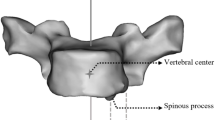Abstract
Purpose
Postoperative shoulder imbalance (PSI) is a common complication of adolescent idiopathic scoliosis (AIS). However, results regarding risk factors for PSI are contradictory. This study was performed to explore the risk factors associated with PSI in AIS and determine whether PSI could be predicted.
Methods
Medical records of AIS patients receiving correction surgery from January 2012 to January 2015 were reviewed. Anteroposterior films were evaluated before and after the surgery and at the 2-year follow-up. Patients were divided into two groups according to whether PSI was observed at 2-year follow-up. Risk factors for PSI were analyzed, and a PSI index was proposed and verified.
Results
A total of 114 AIS patients (PSI/non-PSI: 60/54) were included. The univariate analysis showed that PTC (proximal thoracic curve), preoperative PTC-to-MTC (main thoracic curve) ratio, preoperative bending Cobb angle of PTC, preoperative bending Cobb angle of the lumbar curve, postoperative PTC, postoperative AVT (apical vertebral translation) of PTC, AVT of PTC at follow-up, and adding-on angle were significantly different between two groups. Adjusted logistic regression analysis showed that postoperative AVT of PTC and adding-on angle were the primary contributors to PSI in patients with AIS. The PSI index was defined as 1.2 × postoperative AVT of PTC + 1.1 × adding-on angle. According to the receiver operating characteristic curve, the cutoff point for the PSI index in predicting the development of PSI was 15. The positive and negative predictive values were 80% and 87%, respectively.
Conclusions
To prevent PSI, we recommend sufficient correction of AVT of PTC and prevention of adding-on.
Graphical abstract
These slides can be retrieved under Electronic Supplementary Material.




Similar content being viewed by others
References
Choudhry MN, Ahmad Z, Verma R (2016) Adolescent idiopathic scoliosis. Open Orthop J 10:143–154. https://doi.org/10.2174/1874325001610010143
Yang M, Li C, Li Y, Zhao Y, Wei X, Zhang G, Fan J, Ni H, Chen Z, Bai Y, Li M (2015) Application of 3D rapid prototyping technology in posterior corrective surgery for Lenke 1 adolescent idiopathic scoliosis patients. Medicine 94:e582. https://doi.org/10.1097/md.0000000000000582
Lonner BS, Ren Y, Yaszay B, Cahill PJ, Shah SA, Betz RR, Samdani AF, Shufflebarger HL, Newton PO (2017) Evolution of surgery for adolescent idiopathic scoliosis over 20 years: have outcomes improved? Spine. https://doi.org/10.1097/brs.0000000000002332
Zhang S, Zhang L, Feng X, Yang H (2017) Incidence and risk factors for postoperative shoulder imbalance in scoliosis: a systematic review and meta-analysis. Eur Spine J. https://doi.org/10.1007/s00586-017-5289-y
Smyrnis PN, Sekouris N, Papadopoulos G (2009) Surgical assessment of the proximal thoracic curve in adolescent idiopathic scoliosis. Eur Spine J 18:522–530. https://doi.org/10.1007/s00586-009-0902-3
Lee CS, Hwang CJ, Lim EJ, Lee DH, Cho JH (2016) A retrospective study to reveal factors associated with postoperative shoulder imbalance in patients with adolescent idiopathic scoliosis with double thoracic curve. J Neurosurg Pediatr 25:744–752. https://doi.org/10.3171/2016.6.peds16162
Yagi M, Takemitsu M, Machida M (2013) Chest cage angle difference and rotation of main thoracic curve are independent risk factors of postoperative shoulder imbalance in surgically treated patients with adolescent idiopathic scoliosis. Spine 38:E1209–1215. https://doi.org/10.1097/BRS.0b013e31829e0309
Namikawa T, Matsumura A, Kato M, Hayashi K, Nakamura H (2015) Radiological assessment of shoulder balance following posterior spinal fusion for thoracic adolescent idiopathic scoliosis. Scoliosis 10:S18. https://doi.org/10.1186/1748-7161-10-s2-s18
Liu Z, Hu ZS, Qiu Y, Zhang Z, Zhao ZH, Han X, Zhu ZZ (2017) Role of clavicle chest cage angle difference in predicting postoperative shoulder balance in Lenke 5C adolescent idiopathic scoliosis patients after selective posterior fusion. Orthop Surg 9:86–90. https://doi.org/10.1111/os.12305
Han X, Liu Z, Qiu Y, Sha S, Yan H, Jin M, Zhu Z (2016) Clavicle chest cage angle difference: is it a radiographic and clinical predictor of postoperative shoulder imbalance in Lenke I adolescent idiopathic scoliosis? Spine 41:1346–1354. https://doi.org/10.1097/brs.0000000000001521
Terheyden JH, Wetterkamp M, Gosheger G, Bullmann V, Liljenqvist U, Lange T, Schulze Bovingloh A, Schulte TL (2017) Predictors of shoulder level after spinal fusion in adolescent idiopathic scoliosis. Eur Spine J. https://doi.org/10.1007/s00586-017-5210-8
Wang Y, Hansen ES, Hoy K, Wu C, Bunger CE (2011) Distal adding-on phenomenon in Lenke 1A scoliosis: risk factor identification and treatment strategy comparison. Spine 36:1113–1122. https://doi.org/10.1097/BRS.0b013e3181f51e95
Akazawa T, Kotani T, Sakuma T, Minami S, Torii Y, Orita S, Inage K, Fujimoto K, Shiga Y, Inoue G, Miyagi M, Saito W, Ohtori S, Niki H (2017) Midlife changes of health-related quality of life in adolescent idiopathic scoliosis patients who underwent spinal fusion during adolescence. Eur J Orthop Surg Traumatol Orthop Traumatol. https://doi.org/10.1007/s00590-017-2027-4
Lenke LG, Bridwell KH, O’Brien MF, Baldus C, Blanke K (1994) Recognition and treatment of the proximal thoracic curve in adolescent idiopathic scoliosis treated with Cotrel-Dubousset instrumentation. Spine 19:1589–1597
Cao K, Watanabe K, Hosogane N, Toyama Y, Yonezawa I, Machida M, Yagi M, Kaneko S, Kawakami N, Tsuji T, Matsumoto M (2014) Association of postoperative shoulder balance with adding-on in Lenke Type II adolescent idiopathic scoliosis. Spine 39:E705–712. https://doi.org/10.1097/brs.0000000000000325
Cil A, Pekmezci M, Yazici M, Alanay A, Acaroglu RE, Deviren V, Surat A (2005) The validity of Lenke criteria for defining structural proximal thoracic curves in patients with adolescent idiopathic scoliosis. Spine 30:2550–2555
Acknowledgements
This study was supported by National Natural Science Fund of China (31870985) and Natural Science Fund of Shanghai (16ZR1449100).
Author information
Authors and Affiliations
Corresponding authors
Ethics declarations
Conflict of interest
The authors declare that they have no conflict of interest.
Additional information
Publisher's Note
Springer Nature remains neutral with regard to jurisdictional claims in published maps and institutional affiliations.
Electronic supplementary material
Below is the link to the electronic supplementary material.
Rights and permissions
About this article
Cite this article
Yang, Y., Yang, M., Zhao, J. et al. Postoperative shoulder imbalance in adolescent idiopathic scoliosis: risk factors and predictive index. Eur Spine J 28, 1331–1341 (2019). https://doi.org/10.1007/s00586-019-05933-2
Received:
Revised:
Accepted:
Published:
Issue Date:
DOI: https://doi.org/10.1007/s00586-019-05933-2




